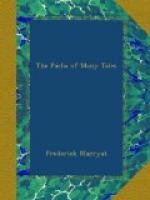We now steered more to the southward, and in three days discovered another small island. It was apparently well wooded, although not large. We hove to, to windward of it, and not perceiving any inhabitants, I lowered down a boat, and sent the first mate on shore to reconnoitre. He returned in an hour, informing me that the island was covered with cocoa-nut trees in full bearing, and that he had seen several wild pigs, but no symptoms of its being inhabited—that there was no anchorage that he could discover, as the shore rose perpendicularly, like a wall, from the ocean. We therefore ran to leeward, and discovered that a reef of coral rocks extended nearly two miles from that side of the island. The boats were again lowered, and after surveying, the mate reported that there was a passage, with plenty of water, for the ship, through the very centre of the reef, which would bring her into a small bay, where she might lay in perfect security. Before night we had gained the anchorage, and furled sails. The next morning I went on shore to reconnoitre; we found some springs of fresh water, cocoa-nuts and other trees in abundance, and occasionally fell in with herds of wild pigs, which appeared, with the exception of birds, to be the only animals that existed upon the island. Satisfied that I now had an opportunity of revictualling my ship, I unbent my sails, struck my topmasts, unrove my running rigging, and, in short, made every preparation for a long stay. I then sent parties on shore to erect tents, and shoot the wild pigs, while I superintended the fixing of coppers on the beach to boil the salt




